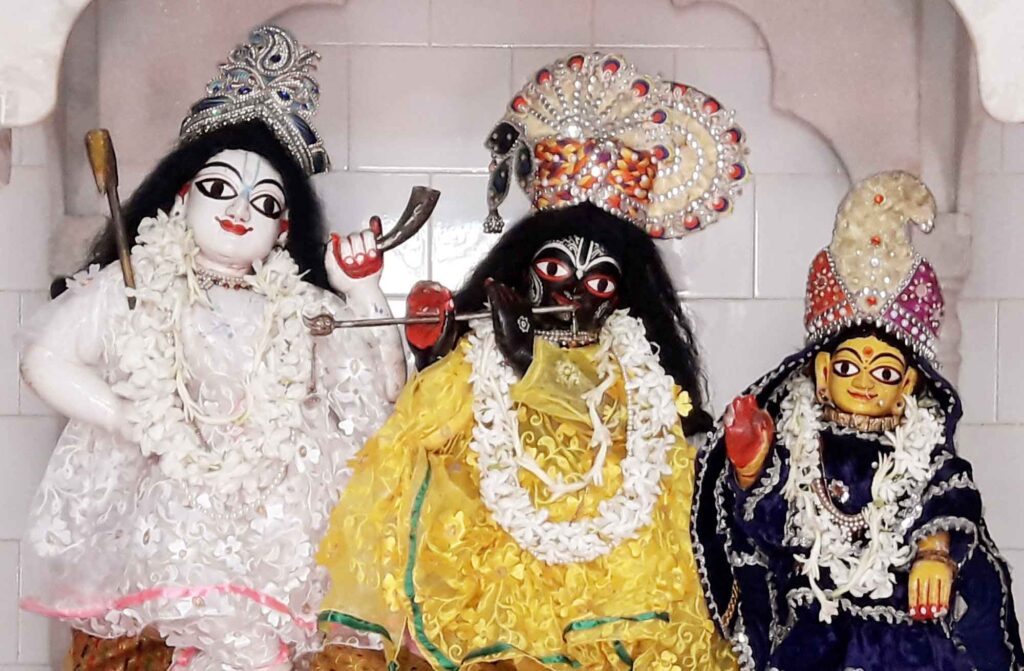Overview
Matsya-Māṁsa Bhojana (Eating Fish and Meat) was first published in Sajjana Toṣaṇī, Vol. 2, issue 8 in 1885. Bhaktivinoda Ṭhākura explains why the young people of Bengal are taking to meat-eating and describes the three types of food in Vedic culture.
(translated by Swami B.V. Giri)
Nowadays, it is a common belief amongst some people that, without eating fish and meat, after some time the human body will not have any strength and the senses will have no potency. This belief is born from the advice of British doctors, the inclination to eat fish and meat, and various foreign superstitions. Especially those persons who are completely controlled by their senses, and are extremely inclined to the notion of satisfying their cravings, try to encourage the inclination for eating fish and meat in our country’s youth. The result is that in the pious land of Bhārata-varṣa, the Aryan descendants, abandoning their traditional food and eating foreign products, are gradually all becoming weaker and impotent. We are not presently talking in regard to major countries that are cold. However, we have a great necessity for vegetarianism in Bhārata-varṣa, which can be easily proven by history and science. We will talk more about this later. I will not discuss this topic for now.
In our country, there are three types of cooked food from ancient times – haviṣyānna bhojana (food fit or pure enough to be offered in sacrifice), nirāmiṣānna bhojana (food without meat) and sāmiṣānna bhojana (food with meat).
Those who eat haviṣyānna bhojana only cook once using ātapa (white rice), certain pulses and grains, some types of fruit and roots, ghee, milk and guḍa (molasses).
Those who nirāmiṣānna bhojana can eat ātapa and siddha (brown boiled rice), a variety of dishes without fish and meat, as well as ghee, milk and an assortment of sweets.
Those who eat sāmiṣānna bhojana can eat meat offered in sacrifice to the Devas and Pitṛs, and fish along with all these things, depending on the country.
These three types of foods are divided into sattva, raja and tama. Sāttvika persons eat haviṣyānna bhojana, rājasika persons eat nirāmiṣānna bhojana, and tāmasika persons eat sāmiṣānna bhojana. A review of all the itihāsa (histories) reveals that the sāttvika persons suffer very little from disease, and have vast capabilities to engage in yoga sādhana etc. Rājasika people suffer less from disease than tāmasika people. Rājasika people soon resort to the sāttvika plane in favour of higher spiritual activities. The dietary provisions of tāmasika people have been arranged only with the intention of gradually improving their instincts by giving them food according to their spiritual tendency. Only on saṅkrānti (when the sun passes into a new zodiac sign), Sundays, parva days (full moon and new moon), hari-vāsara (Ekādaśī) etc. are tāmasika people forbidden to eat fish and meat. All these provisions are unnecessary for sāttvika and rājasika people. The difference between sāttvika and rājasika persons is that sāttvika persons never accept rājasika and tāmasika food. Due to mixed association, rājasika persons sometimes accept tāmasika things.
Some may ask that if all benefits can be obtained simply by eating sāttvika food, then why do we not become free from disease, or acquire yogic skills or spiritual abilities after eating only sāttvika food for a few days? The answer is that human nature does not depend upon food alone. Eating, conduct and spiritual endeavours are the three kinds of activities that improve human nature. Firstly, by sāttvika food, one’s existence becomes purified. The word sattva pertains to the body and mind. Even if one’s physical existence is pure, if one’s conduct is not completely sāttvika, then that pure existence will gradually become degraded. The word vyavahara (conduct) should be understood to mean all conduct, and not just eating. Vyavahara includes all rules and regulations such as giving up the illicit company of women, truth, simplicity, non-violence etc. As long as human beings do not engage in regular spiritual practices, even if their food and conduct are good, what form will the complete improvement of human nature take? If one wants to see the results of sāttvika improvement, then it can be observed in those that have taken sāttvika food and have engaged in sāttvika practices from birth. Of course one will attain the result. Yet if there is a defect in any part, the result will be obstructed. In order to attain the qualification for proper conduct and practice, first it is necessary to take sāttvika food.
There are many examples of human improvement through proper food, conduct and practice. We show our youth the behaviour of Theosophists and Muslim fakirs because they have more respect for foreign philosophies. Muslims, Buddhists and Theosophists have become aware of the procedures for human development to a certain extent, and have accomplished many tasks. Can there be any doubt that true Aryan and Vedic purity, and the results born from it, are more effective here?
We can give many examples for the benefit of our new youth. Amongst them, today I will give one example, which they can check. Śrīyuta Candra-Nārāyaṇa Caṭṭopādhyāya Mahāśaya, the famous resident of Uttarpāḍā is fifty-two years old. He has been eating haviṣyānna since he was ten years old. He has plenty of strength in his body and all his senses. His eyes are very bright. His paternal uncle, Prema-Nārāyaṇa Caṭṭopādhyāya Mahāśaya, has enjoyed good health by eating nirāmiṣānna bhojana for 70 years.













